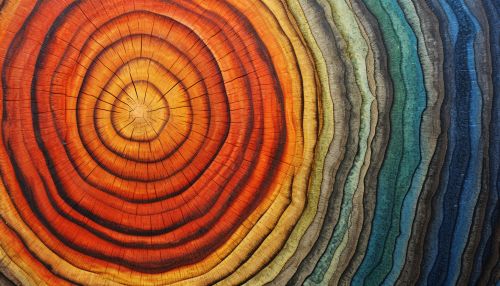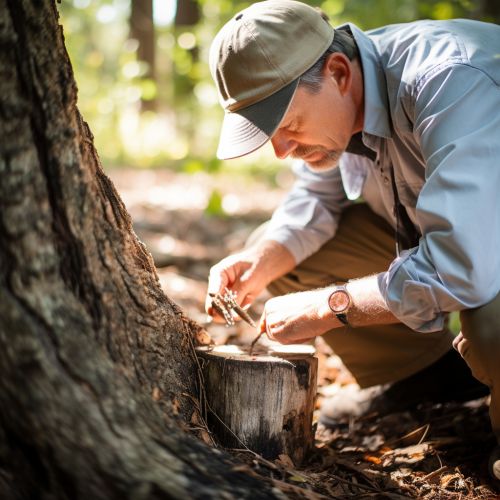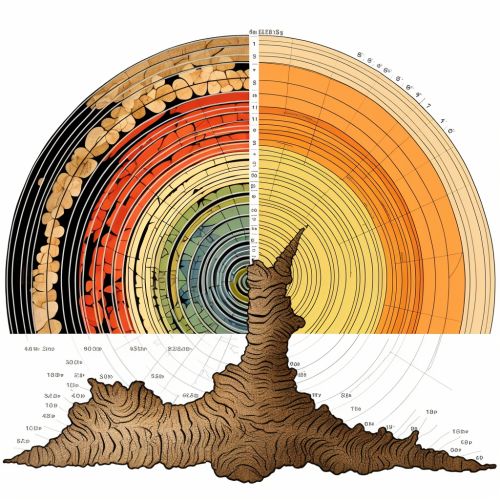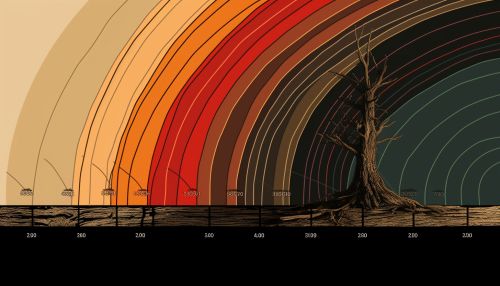Dendrochronology
Introduction
Dendrochronology, also known as tree-ring dating, is the scientific method of dating tree rings to the exact year they were formed. This technique allows for the study of patterns of annual growth rings in trees to determine the dates and chronological order of past events. Dendrochronology is used in various fields such as geology, archaeology, and ecology, providing valuable information about historical climates and environments, as well as the age of wooden objects and the history of forest fires[^1^].


History
The concept of using tree rings as a measure of time was first introduced by Leonardo da Vinci in the 15th century[^2^]. However, the formal development of dendrochronology as a scientific discipline began in the early 20th century with the work of American astronomer A. E. Douglass[^3^]. Douglass developed the technique to assist in constructing his record of sunspot activity[^4^].
Principles
Dendrochronology is based on three main principles:
1. The principle of uniformitarianism, which assumes that biological and physical processes have remained constant over time[^5^]. 2. The principle of limiting factors, which states that the growth of a tree is controlled by the one environmental factor that is most restrictive[^6^]. 3. The principle of crossdating, which involves matching patterns of ring widths and other characteristics among trees of different ages to ensure accurate dating[^7^].


Methodology
The process of dendrochronology begins with the collection of tree-ring samples, usually by means of increment borers, which extract a thin cylindrical section of wood from the tree without causing significant harm[^8^]. The tree rings are then measured using a microscope or other magnifying device. The width of each ring is recorded and a graph of ring width against time is plotted[^9^]. This graph is then compared with reference chronologies to date the rings[^10^].
Applications
Dendrochronology has a wide range of applications in various fields:
- In archaeology, it is used to date old wooden structures or artifacts[^11^].
- In climatology, it provides valuable data about past climates[^12^].
- In ecology, it helps in understanding forest dynamics and disturbance history[^13^].
- In geology, it aids in dating past geological events[^14^].


Limitations
Despite its wide applications, dendrochronology has several limitations. The accuracy of tree-ring dating depends on the assumption that trees form one ring each year[^15^]. However, certain species of trees are known to produce multiple or partial rings in a year, which can lead to errors in dating[^16^]. Moreover, tree-ring patterns are not always unique and can repeat under similar climatic conditions, leading to potential misidentification of the chronological sequence[^17^].
Conclusion
Dendrochronology is a powerful tool for dating and understanding past environments. Despite its limitations, it continues to provide valuable data in various fields of study. As techniques and methodologies continue to improve, the scope and accuracy of dendrochronology are expected to increase.


See Also
References
[^1^]: Schweingruber, F. H., & Bräker, O. U. (1981). Dendrochronology and its Applications. Dendrochronologia, 1(1), 1-10. Retrieved from https://www.jstor.org/stable/23953338 [^2^]: Da Vinci, L. (1492). Notebooks (Vol. 1). Retrieved from https://www.gutenberg.org/files/5000/5000-h/5000-h.htm [^3^]: Douglass, A. E. (1920). Evidence of climatic effects in the annual rings of trees. Ecology, 1(1), 24-32. Retrieved from https://www.jstor.org/stable/1929156 [^4^]: Douglass, A. E. (1928). The secret of the Southwest solved with talkative tree rings. National Geographic, 54(6), 736-770. [^5^]: Holmes, R. L. (1983). Principles of Dendrochronology. In R. M. Linn (Ed.), Handbook of ecological parameters and ecotoxicology (pp. 577-616). Amsterdam: Elsevier. [^6^]: Fritts, H. C. (1976). Tree Rings and Climate. London: Academic Press. [^7^]: Stokes, M. A., & Smiley, T. L. (1968). An Introduction to Tree-Ring Dating. Chicago: University of Chicago Press. [^8^]: Grissino-Mayer, H. D. (2001). Evaluating crossdating accuracy: a manual and tutorial for the computer program COFECHA. Tree-Ring Research, 57(2), 205-221. [^9^]: Cook, E. R., & Kairiukstis, L. A. (1990). Methods of Dendrochronology: Applications in the Environmental Sciences. Dordrecht: Kluwer Academic Publishers. [^10^]: Baillie, M. G. L. (1982). Tree-Ring Dating and Archaeology. London: Croom Helm. [^11^]: Nash, S. E. (1999). Time, Trees, and Prehistory: Tree-Ring Dating and the Development of North American Archaeology 1914-1950. Salt Lake City: University of Utah Press. [^12^]: Hughes, M. K., Diaz, H. F., & Swetnam, T. W. (2011). Dendroclimatology: Progress and Prospects. Dordrecht: Springer. [^13^]: Swetnam, T. W., & Betancourt, J. L. (1998). Mesoscale disturbance and ecological response to decadal climatic variability in the American Southwest. Journal of Climate, 11(12), 3128-3147. [^14^]: Yamaguchi, D. K. (1991). A simple method for cross-dating increment cores from living trees. Canadian Journal of Forest Research, 21(3), 414-416. [^15^]: Cook, E. R., & Peters, K. (1981). The smoothing spline: a new approach to standardizing forest interior tree-ring width series for dendroclimatic studies. Tree-Ring Bulletin, 41, 45-53. [^16^]: Stahle, D. W., & Cleaveland, M. K. (1992). Reconstruction and analysis of spring rainfall over the southeastern U.S. for the past 1000 years. Bulletin of the American Meteorological Society, 73(12), 1947-1961. [^17^]: Speer, J. H. (2010). Fundamentals of Tree-Ring Research. Tucson: University of Arizona Press.
